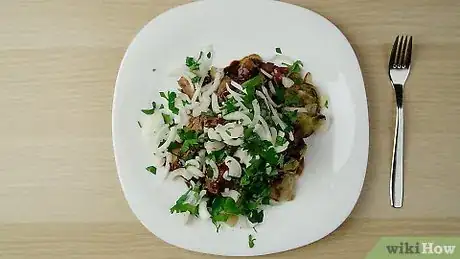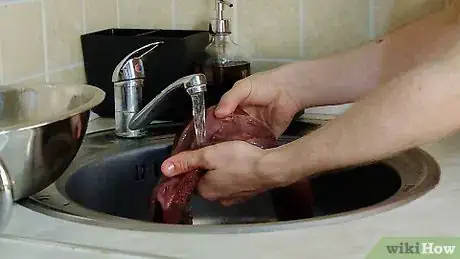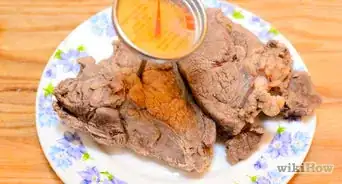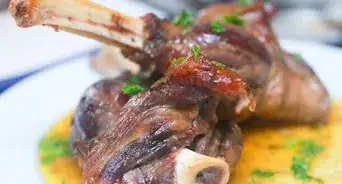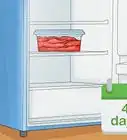This article was co-authored by wikiHow Staff. Our trained team of editors and researchers validate articles for accuracy and comprehensiveness. wikiHow's Content Management Team carefully monitors the work from our editorial staff to ensure that each article is backed by trusted research and meets our high quality standards.
There are 8 references cited in this article, which can be found at the bottom of the page.
The wikiHow Video Team also followed the article's instructions and verified that they work.
This article has been viewed 50,105 times.
Learn more...
Lamb’s liver is an inexpensive cut of meat that packs in plenty of flavor. It happens to be very simple to cook, since all you need to do is trim and slice it. A piece of liver can easily be pan-fried in olive oil or butter within 10 minutes. To add more flavors, create a glaze or blend the liver into a pâté. You can cook lamb’s liver with bacon, potatoes, and many other ingredients to create a unique meal.
Ingredients
Makes 4 servings
- 1 lb (450 g) lamb’s liver
- 0.17 oz (4.8 g) salt
- 0.17 oz (4.8 g) pepper
- 1 US tbsp (15 mL) olive oil
- 0.88 oz (25 g) butter
Makes 4 servings
- 2 banana shallots, diced
- 5 sprigs of fresh parsley, chopped
- 1 garlic clove, diced
- 1 US tbsp (15 mL) olive oil
- 5 oz (140 g) thick-cut smoked bacon, diced
- 2 Little Gem lettuce, cut in half lengthwise
- 2 large Portobello mushrooms, sliced
- 2 US tbsp (30 mL) chicken stock
- 2 1⁄4 oz (64 g) butter
- 1 lb (0.45 kg) lamb’s liver
- 1⁄2 oz (14 g) flour
- 0.17 oz (4.8 g) salt
- 0.17 oz (4.8 g) pepper
- 4 US tbsp (59 mL) balsamic vinegar
- 2 US tbsp (30 mL) beef stock
Makes 5 to 6 servings
- 12.3 oz (350 g) lamb’s liver
- 5.2 oz (150 g) butter
- 1 US tbsp (15 mL) olive oil
- 0.5 oz (14 g) rosemary
- 1 clove of garlic, mashed
- 1 US tbsp (15 mL) port wine
- 0.17 oz (4.8 g) salt
- 0.17 oz (4.8 g) pepper
- 2.5 fl oz (74 mL) double cream
- 2.5 fl oz (74 mL) crème fraîche
Steps
Pan-Fried Lamb’s Liver
-
1Slice the liver into strips about 3 in (7.6 cm) thick. Start on 1 side of the liver, cutting it lengthwise. Keep each piece as uniform as possible. You can make the slices smaller if you would like, but remember that smaller pieces cook faster.
- You can also slice the liver horizontally into steaks. The steaks will cook evenly as long as they are thin and flat. However, you won’t be able to fit more than 1 into the pan at a time.
-
2Heat butter or olive oil over medium heat. Add about 1 US tbsp (15 mL) of oil or butter to a large frying pan. You can use either substance to cook the liver the same way. Wait for the butter or oil to get hot enough before you add the liver.
- If you use butter, wait for it to melt and begin to foam. For olive oil, heat it until it sizzles, but remove the pan from heat if the oil begins to smoke.
Advertisement -
3Put the liver in the pan and season it with salt and pepper. Set the liver in the oil or butter, then apply the seasoning directly to its top. Use about 1 teaspoon, or .17 oz (4.8 g), of both salt and pepper. Sprinkle it as evenly across the liver as you can.[1]
- Season the liver to your tastes. You can always use more or less seasoning.
-
4Fry the liver for 3 to 4 minutes on each side. Leave the liver still in the butter or oil for a couple of minutes. The side down in the pan will begin to brown. After a couple of minutes pass, flip the liver over so the top side is down in the pan. Wait for each piece of liver to finish browning.
- The cooking time varies depending on the thickness of the liver. Thinner pieces may require less cooking time.
-
5Check the liver for a brown coloring to make sure it is done cooking. A finished piece of liver is golden brown on the outside but slightly pink in the center. Leaving the center pink prevents the liver from overcooking. You can test the liver’s doneness by cutting into it. You can also use a kitchen thermometer to make sure the temperature in the center of the meat is at least 158 °F (70 °C).
- Overcooked liver is chewy and grainy. If you have had overcooked steak, you know how unpleasant overcooked liver is to eat!
Balsamic-Glazed Lamb’s Liver
-
1Slice the liver and the other ingredients. Slice 1 lb (0.45 kg) of cleaned liver into small pieces or thin halves. Dice 2 banana shallots, 1 clove of garlic, and 5 oz (140 g) of thick, smoked bacon by cutting them into small cubes. Chop up about 5 sprigs of fresh parsley and 2 Portobello mushrooms.[2]
- Separate the shallots, garlic, and parsley from the other ingredients. Add them to a separate mixing bowl and set it aside.
- If you have lettuce, cut the leaves in half lengthwise. You can also make potatoes, a mash, or use other fresh vegetables in place of the lettuce.
-
2Heat 1 US tbsp (15 mL) of olive oil over low heat. Choose a frying pan big enough to hold all of the bacon and some of the other ingredients. Start with the oil, heating it for about 2 or 3 minutes.[3]
- Make use of a big pan, since it will need to hold some of the bigger ingredients for a while.
-
3Fry the bacon for about 3 minutes until it is golden brown. Place all of the bacon in the heated pan. Leave the heat on low, letting the bacon gradually crisp. Keep an eye on the pan so the bacon doesn’t overcook.[4]
- Cooking on low heat ensures that the pan doesn’t get too hot. This way, the bacon will fry evenly without burning.
-
4Cook the lettuce, mushroom, and chicken stock for 20 minutes. Place the lettuce with the cut-side facing down. Mix in the sliced mushrooms, then pour in 2 US tbsp (30 mL) of chicken stock. Leave the pan alone for at least 15 minutes as the ingredients simmer.[5]
- While waiting for these ingredients to finish, begin cooking the liver.
-
5Heat a frying pan with butter over low heat. Get a second frying pan, this one big enough to hold the liver. Set it on the stove to begin warming it up. Add 1 1⁄8 oz (32 g) of butter, letting it warm until it melts and begins foaming.[6]
- A large frying pan should be big enough. You won’t need to add all of the remaining ingredients at once, so space probably won’t be an issue.
-
6Pour the flour into a separate container and season it. You can use a mixing bowl, plastic container, or any other holding container you have on hand. To avoid wasting any flour, start with about 1 tablespoon (15 ml), or 1⁄2 oz (14 g). Sprinkle about 0.17 oz (4.8 g), or 1 teaspoon each, of salt and pepper.[7]
- You can season the flour with other spices such as paprika or adjust the ratio of salt and pepper.
-
7Coat the liver pieces in flour. Dredge the liver by rolling it around in the flour. The flour will stick to the liver’s outer surface. All you need is a light, even coating on the liver so it turns nice and brown when cooked.[8]
- Add more flour and seasoning to the container as needed to coat the liver.
-
8Cook the liver for about 2 minutes on each side. Make sure the butter is foaming before you add the liver or else it won’t be hot enough to brown the liver thoroughly. Leave the liver to cook, then flip it over and cook the other side. Take the liver out of the pan when it is finished.[9]
- You can cook the liver in multiple batches if you don’t have enough space in your pan.
- The liver should be golden brown on the outside and slightly pink in the center. Test it with a thermometer to make sure it cooks through.
-
9Pour the vinegar into the pan and scrape up the brown bits. Add 4 US tbsp (59 mL) of balsamic vinegar to the now-empty pan. Look for some charred bits left over at the bottom of the pan from cooking the liver. Use a spatula to loosen the bits and mix them into the vinegar.[10]
- This is called deglazing, a process which adds a lot of flavor to the sauce.
-
10Mix in butter and beef stock, cooking the sauce until it thickens. Add 1 1⁄8 oz (32 g) of butter to the pan, followed by 2 US tbsp (30 mL) of beef stock. Let the butter melt. Using a whisk, stir all of the ingredients into a sauce. Allow the sauce to simmer for at least 2 minutes so it thickens slightly.[11]
- Cook the sauce for longer if it doesn’t thicken right away. The amount of time needed can vary depending on your stove.
- Taste the sauce when it is done. Mix in more salt and pepper if you would like.
-
11Combine all of the ingredients on plates. Starting with the lettuce, use a spoon to divide up the ingredients between 4 plates. Position the lettuce on the plates, then place the liver on top of it. Pour the balsamic sauce over the liver, followed by the shallot mixture. Finish by enjoying the lamb’s liver.[12]
- You can adjust the recipe in different ways. For example, you can make gravy instead of a balsamic sauce.
Lamb Liver and Rosemary Pâté
-
1Crush the garlic and chop the rosemary. Using the heel of your palm to crush a clove of garlic with your knife. Cut about 0.5 oz (14 g) of fresh rosemary. Also, slice up the liver so you can fit it all in a frying pan.[13]
- Remember to pat the liver dry before you begin cooking it. Slice it into smaller pieces so it cooks faster.
-
2Heat butter and olive oil in a frying pan. Choose a large pan, big enough to hold all of the liver. Pour in a combination of 1 US tbsp (15 mL) of olive oil, followed by about 1.8 oz (51 g) of butter. Heat the pan over medium heat until the butter melts and froths.[14]
- It is possible to cook the liver in only butter or oil, if you want. Oil is good for frying the liver, but butter helps hold the pâté together.
-
3Add garlic, rosemary, and port wine before cooking the liver. Move the garlic and rosemary to the pan, then follow it with 3 US tbsp (44 mL) of port wine. Immediately put the liver in and cook each side for 3 or 4 minutes.[15]
- The liver should be brown on the outside and light pink in the center. Cut into it or use a meat thermometer to test it.
-
4Move the frying pan’s contents to a blender. Carefully dump everything in the pan into the blender or food processor. You may want to move the liver to a separate plate, so you can pour the liquids in first. Scrape the garlic and rosemary in with a spatula before following up with the liver.[16]
-
5Add seasonings before blending the ingredients smooth. For this recipe, drop 3.5 oz (99 g) of butter into the blender. Also add 2.5 fl oz (74 mL) of double cream and 2.5 fl oz (74 mL) of crème fraîche. Finish it off with about 0.17 oz (4.8 g), or 1 teaspoon, of salt and pepper. Turn the blender on at a high-speed setting and gradually blitz it until the ingredients look smooth and liquid.[17]
- You can adjust the recipe’s flavor by adding different ingredients to the blender. For example, you might leave out the cream and add allspice or alternative spices.
-
6Pour the pâté into a container. To make individual servings, divide the pâté into 4 to 6 ramekins. If you don’t have small containers, you can pour the entire pâté into a bowl and it will be fine.
-
7Set the pâté in the refrigerator. Cool temperatures allow the liver to set, giving it a more solid consistency similar to a loaf you can cut. This will take between 15 to 30 minutes. Then, you can eat the liver with a spoon or with bread or crackers.[18]
- The pâté cools quicker when it is divided into smaller portions, so you may need to give it more time to cool if it is in 1 big container.
- If you don’t plan on eating the pâté right away, melt another 1.8 oz (51 g) of butter and pour it over the pâté. It helps the pâté keep its shape.
Cleaning the Liver
-
1Pull the membrane off the outside of the liver. Not all livers will still have the membrane on when you buy them. Look for a white, almost transparent film over the dark, red liver. You can also detect it by touching the liver, feeling for a soft, slimy substance. Reach your fingers underneath the membrane and pull it off of the liver completely.[19]
- If the membrane sticks the liver, cut it off carefully using kitchen scissors or a sharp knife. Try to position the blade away from the liver so you don’t accidentally cut it.
- A good piece of liver will be dark red, smooth, and firm to the touch. If the membrane is there, it will affect how the liver looks and feels.
-
2Cut off any exposed veins or tubes with a sharp blade. Look over the liver to make sure it is flat and smooth before you cook it. The liver may have noticeable veins and tubes on its surface. They will look round and gristly. Slice them off as close to the liver as possible with a sharp pair of kitchen scissors or a knife.[20]
- Be sure to remove any remaining connective tissue you notice. The tissue will look like white streaks, the same as the membrane you may have removed earlier.
- The parts you removed are rough and not tasty, so you can throw them away.
-
3Rinse the liver under running water. Get a stream of cool water flowing in your sink. Use the water to ensure that any remaining gristle or membrane pieces are gone. The liver should look and feel completely smooth when you are done.[21]
- You can safely skip rinsing if you are sure you have removed all of the tubes and membrane. Any bacteria on the liver will be taken care of during the cooking process.
-
4Pat the liver dry before cooking it. Set a paper towel on your countertop. Dab the liver with a second paper towel until it feels dry. You should do this even if you didn’t rinse the liver. This is because a dry piece of liver cooks more evenly than a piece with moisture on it.
- Take extra time to dry the liver if you rinsed it off. Use multiple paper towels as needed.
Things You’ll Need
Cleaning the Liver
- Knife or kitchen scissors
- Sink
- Paper towel
Pan-Fried Lamb’s Liver
- Stove
- Frying pan
- Kitchen thermometer
Balsamic-Glazed Lamb’s Liver
- Stove
- 2 frying pans
- Knife
- Spatula
- Spoon
- Mixing bowl or container
Lamb Liver and Rosemary Pâté
- Stove
- Frying pan
- Knife
- Blender or food processor
- Ramekins or another container
References
- ↑ https://www.goodhousekeeping.co.uk/institute/cookery-videos/lamb/how-to-cook-lambs-liver
- ↑ https://www.bbc.com/food/recipes/lambs_liver_with_60023
- ↑ https://www.bbc.com/food/recipes/lambs_liver_with_60023
- ↑ https://www.bbcgoodfood.com/recipes/2723/liver-and-bacon-saut-with-potatoes-and-parsley
- ↑ https://www.bbc.com/food/recipes/lambs_liver_with_60023
- ↑ https://www.bbc.com/food/recipes/lambs_liver_with_60023
- ↑ https://www.bbc.com/food/recipes/liver_and_bacon_with_94841
- ↑ https://www.bbc.com/food/recipes/lambs_liver_with_60023
- ↑ http://www.recipetips.com/recipe-cards/t--3236/balsamic-glazed-lamb-liver.asp
- ↑ https://www.bbc.com/food/recipes/lambs_liver_with_60023
- ↑ https://www.bbc.com/food/recipes/lambs_liver_with_60023
- ↑ https://www.bbc.com/food/recipes/lambs_liver_with_60023
- ↑ http://frugalfeeding.com/2014/12/24/lamb-liver-rosemary-pate/
- ↑ http://frugalfeeding.com/2014/12/24/lamb-liver-rosemary-pate/
- ↑ http://frugalfeeding.com/2014/12/24/lamb-liver-rosemary-pate/
- ↑ https://www.simplybeefandlamb.co.uk/recipes/coarse-liver-pate/
- ↑ http://frugalfeeding.com/2014/12/24/lamb-liver-rosemary-pate/
- ↑ http://frugalfeeding.com/2014/12/24/lamb-liver-rosemary-pate/
- ↑ https://www.goodhousekeeping.co.uk/institute/cookery-videos/lamb/how-to-cook-lambs-liver
- ↑ https://www.goodhousekeeping.co.uk/institute/cookery-videos/lamb/how-to-cook-lambs-liver
- ↑ https://www.simplybeefandlamb.co.uk/recipes/pan-cooked-lambs-liver-and-onions/
About This Article
Before you cook lamb liver, pull or cut off the translucent white membrane on the outside. If you see any white veins or tubes, cut those off, too. Then, rinse the liver and pat it dry with a paper towel. Slice the liver evenly into strips, then heat some butter or olive oil in a pan. Once it starts to sizzle, place the liver in the pan, frying for 3 to 4 minutes on each side, until the outside is golden brown. To learn some recipes you can make with lamb liver, scroll down!




